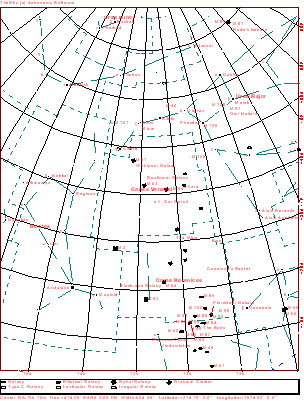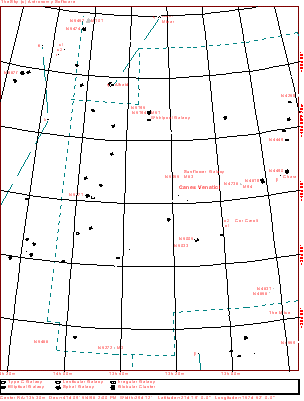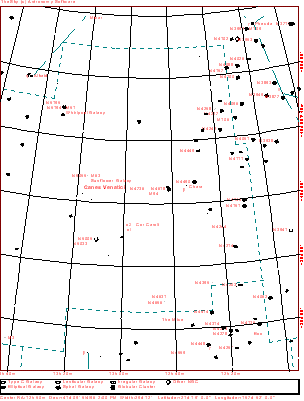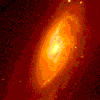
| Home | Deepsky Atlas | TheAstronews | Links | Solar System | ||||||

Hawaiian Astronomical SocietyConstellations: Canes Venatici -- Boötes Hunting Dogs |
||||||||||
First depicted in Johann Hevelius' 1690 atlas the Firmamentum Sobieski, these are Boötes' hunting dogs, Astarion and Chara. Indeed, beta Canum Venaticorum is called Chara. The alpha star, however, received the name, Cor Caroli (the heart of Charles) from Edmond Halley (1656-1742). With the death of Oliver Cromwell (1599-1658), the English had decided they had had enough of "lord protectors of the commonwealth," and asked for their king back. Charles II returned to England in 1660. The royal physician reported that alpha, always slightly variable, shone especially bright on Charles' return. The new king carried on in the high diplomatic traditions of his father, Charles I (executed at the behest of Cromwell). He had Cromwell disinterred, hanged, and beheaded in 1661.

Click the map for a 909x1199 version of the above. Click here for a map better suited for use in the field.

This a more detailed view of the constellation. The map displays stars to magnitude 10, and deepsky objects to magnitude 12. Click here for a map better suited for use in the field.

Click here for a map better suited for use in the field.
The Whirlpool Galaxy in Canes Venatici (NGC 5194/5195) Object type: Spiral (Sc type) galaxy Distance from Earth: + 15,000,000 light years / 4.6 Mparsecs
M51 is actually a pair of spiral galaxies that are being shaped by their gravitational interaction. NGC 5194 is the larger galaxy, weighing roughly 100 billion times as much as the sun. It is about three times larger than its companion galaxy, NGC 5195.
We find M51 3.5° SW of Alkaid, the final star in the Big Dipper's handle. Dreyer describes it as "great spiral nebula." This mag. 9 galaxy shows spiral structure in a 6" telescope. Size is 9'x7.5'.
   The first (55k GIF) is an image by Jason Ware. The second (94k GIF): M51 taken with a C8 on G11, 36 minutes exposure at F/6.3, full resolution. Seeing was not as good as usual but still, with an ST7, the details....(Benoit Schilling). The third (80k GIF) is an image that captured a Supernova in the early 1990s. The first (55k GIF) is an image by Jason Ware. The second (94k GIF): M51 taken with a C8 on G11, 36 minutes exposure at F/6.3, full resolution. Seeing was not as good as usual but still, with an ST7, the details....(Benoit Schilling). The third (80k GIF) is an image that captured a Supernova in the early 1990s.
|
 37k JPEG M63 (NGC5055, or the Sunflower Galaxy) is a very bright (mag. 9.7), large (15'x9'), elongated (120° PA), spiral galaxy located between M51 and Cor Caroli (alpha Canum Venaticorum). Image from the Digital Sky Survey. 37k JPEG M63 (NGC5055, or the Sunflower Galaxy) is a very bright (mag. 9.7), large (15'x9'), elongated (120° PA), spiral galaxy located between M51 and Cor Caroli (alpha Canum Venaticorum). Image from the Digital Sky Survey.
|
 68k JPEG NGC5005 (Best 40, Caldwell 29) is a spiral galaxy located .2° ESE of Cor Caroli (alpha Canum Venaticorum), and located in the top, right of the photograph. Dreyer calls it very bright (mag. 10.9), very large (5.7'x2.7'), and very elongated (PA 66°). It has an extremely bright nucleus embedded in a larger, bright lens. Larger scopes will see several knotted arms. NGC5033 (Best 41) is the other significant galaxy to the lower, left. Described as very bright (mag. 10.6), fairly large (11'x5'), and elongated (PA 167°), it features a sharply defined, very bright, bulging nucleus, and a spiral pattern of dark lanes. The other somewhat obvious galaxy on the far right is the mag. 14.4 NGC5002. The quite faint (mag. 13), very large (6'x5.5'), and irregularly shaped IC4182 (not pictured) lies 1.2° WNW of 5005. From the Digital Sky Survey. 68k JPEG NGC5005 (Best 40, Caldwell 29) is a spiral galaxy located .2° ESE of Cor Caroli (alpha Canum Venaticorum), and located in the top, right of the photograph. Dreyer calls it very bright (mag. 10.9), very large (5.7'x2.7'), and very elongated (PA 66°). It has an extremely bright nucleus embedded in a larger, bright lens. Larger scopes will see several knotted arms. NGC5033 (Best 41) is the other significant galaxy to the lower, left. Described as very bright (mag. 10.6), fairly large (11'x5'), and elongated (PA 167°), it features a sharply defined, very bright, bulging nucleus, and a spiral pattern of dark lanes. The other somewhat obvious galaxy on the far right is the mag. 14.4 NGC5002. The quite faint (mag. 13), very large (6'x5.5'), and irregularly shaped IC4182 (not pictured) lies 1.2° WNW of 5005. From the Digital Sky Survey.
|
 5k JPEG M94 (NGC4736) is a very bright (mag. 8.7), large (14'x12'), elongated (105° PA), spiral galaxy located 3 ° NW of Cor Caroli (alpha Canum Venaticorum). Image is three, three minute exposures using a HISYS CCD on a C14 at f6. 5k JPEG M94 (NGC4736) is a very bright (mag. 8.7), large (14'x12'), elongated (105° PA), spiral galaxy located 3 ° NW of Cor Caroli (alpha Canum Venaticorum). Image is three, three minute exposures using a HISYS CCD on a C14 at f6.
|
 45k JPEG NGC4631 (Best 38, Caldwell 32) is a spiral galaxy located 6.4° SSW of Cor Caroli (alpha Canum Venaticorum), and located in the top, right of the photograph. Dreyer calls it very bright (mag. 9.3), very large (14'x2'), and very elongated (PA 86°). It has a bright, slightly off-center nucleus with a star just north of it. NGC4627 is the small galaxy just 2'-3' to the north. NGC4656 (Best 39) is the other large galaxy to the lower, left. Described as fairly bright (mag. 10.6), large (15'x3'), and very elongated (PA 34°), it, too, has a faint companion to the north (NGC4657) that is partly superimposed. From the Digital Sky Survey. 45k JPEG NGC4631 (Best 38, Caldwell 32) is a spiral galaxy located 6.4° SSW of Cor Caroli (alpha Canum Venaticorum), and located in the top, right of the photograph. Dreyer calls it very bright (mag. 9.3), very large (14'x2'), and very elongated (PA 86°). It has a bright, slightly off-center nucleus with a star just north of it. NGC4627 is the small galaxy just 2'-3' to the north. NGC4656 (Best 39) is the other large galaxy to the lower, left. Described as fairly bright (mag. 10.6), large (15'x3'), and very elongated (PA 34°), it, too, has a faint companion to the north (NGC4657) that is partly superimposed. From the Digital Sky Survey.
|
 54k JPEG A CCD image of the globular cluster M3 (NGC 5272) scaled to show maximum detail through to the core. 100 second exposure using a 10" Meade LX200 nd 16 bit Hale Research EAC512 CCD camera from urban Coventry UK. M3 is a fine (mag. 6.4, size 16') globular cluster located near the Boötes and Coma Berenices border. Dreyer describes it as extremely bright, very large, with a condensed core. He estimated the stars shone at mag. 11, i.e. a 3" refractor in a dark sky could begin to resolve this one. 54k JPEG A CCD image of the globular cluster M3 (NGC 5272) scaled to show maximum detail through to the core. 100 second exposure using a 10" Meade LX200 nd 16 bit Hale Research EAC512 CCD camera from urban Coventry UK. M3 is a fine (mag. 6.4, size 16') globular cluster located near the Boötes and Coma Berenices border. Dreyer describes it as extremely bright, very large, with a condensed core. He estimated the stars shone at mag. 11, i.e. a 3" refractor in a dark sky could begin to resolve this one.
|
 34k JPEG NGC4490 (Best 37) is the brighter (mag. 10.3) of an interacting galaxy pair. The fainter (mag. 12.5) galaxy is NGC4485. Dreyer describes 4490 as very bright, very large (7'x3.5'), and moderately elongated in PA 130. NGC4485 is bright, fairly small (3'x2.5'), and somewhat out of round. You find them both .7° WNW of Chara (Beta Canum Venaticorum). From the Digital Sky Survey. 34k JPEG NGC4490 (Best 37) is the brighter (mag. 10.3) of an interacting galaxy pair. The fainter (mag. 12.5) galaxy is NGC4485. Dreyer describes 4490 as very bright, very large (7'x3.5'), and moderately elongated in PA 130. NGC4485 is bright, fairly small (3'x2.5'), and somewhat out of round. You find them both .7° WNW of Chara (Beta Canum Venaticorum). From the Digital Sky Survey.
|
 35k JPEG NGC4449 (Best 36, Caldwell 21) is a mag. 10.1 irregular galaxy located 2.9° NNE of Chara (beta Canum Venaticorum). Dreyer says it is very bright, quite large (6'x4.5'), and moderately elongated. He also calls it extremely resolvable. He means it should be possible to see bright and dark areas surrounding a stellar nucleus. From the Digital Sky Survey. 35k JPEG NGC4449 (Best 36, Caldwell 21) is a mag. 10.1 irregular galaxy located 2.9° NNE of Chara (beta Canum Venaticorum). Dreyer says it is very bright, quite large (6'x4.5'), and moderately elongated. He also calls it extremely resolvable. He means it should be possible to see bright and dark areas surrounding a stellar nucleus. From the Digital Sky Survey.
|
  M106 (NGC 4258) is a mag. 9.3 galaxy located in the NW section of the constellation. It features bright knots in its spiral arms. First image: A colour ST6 CCD image of M106. Taken with a 12 inch Meade LX200 at F6.3. RGB ratio of 5:10:15 mins. by Adrian Catterall. The second image is a close-up observatory photo. M106 (NGC 4258) is a mag. 9.3 galaxy located in the NW section of the constellation. It features bright knots in its spiral arms. First image: A colour ST6 CCD image of M106. Taken with a 12 inch Meade LX200 at F6.3. RGB ratio of 5:10:15 mins. by Adrian Catterall. The second image is a close-up observatory photo.
|
 49k JPEG NGC4244 (Best 35, Caldwell 26) is an edge on spiral galaxy located 7.6° due west of Cor Caroli (alpha Canum Venaticorum). Dreyer calls it pretty bright (mag. 10.6), very large (19'x2.3'), and extremely elongated (PA 48°). It has a stellar nucleus, and is the northern element of a pair of galaxies. 49k JPEG NGC4244 (Best 35, Caldwell 26) is an edge on spiral galaxy located 7.6° due west of Cor Caroli (alpha Canum Venaticorum). Dreyer calls it pretty bright (mag. 10.6), very large (19'x2.3'), and extremely elongated (PA 48°). It has a stellar nucleus, and is the northern element of a pair of galaxies.
NGC4214 (Best 34) is an irregular galaxy lying 1.5° south of NGC4244. Dreyer's description reads: quite bright (mag. 10.2), quite large (8.4'x6.6'), irregular extended, with a double nucleus. The double nucleus requires larger aperture. An 8" may show no nucleus at all. It is the southern element of the pair. NGC4190 (mag. 13.2, 1.6'x1.5') lies 30' to the north-west of NGC4214.
Mosaic from the Digital Sky Survey.
|
 44k Labeled JPEG NGC4111 (Best 33) is an edge on spiralish galaxy located near the Ursa Major border, 6° south-east of Chi Ursae Majoris, and 5.2° WNW of Chara (Beta Canum Venaticorum). Dreyer's description reads very bright (mag. 11.6), fairly small (4.5'x0.9'), and moderately extended (p.a. 151°). It has a stellar nucleus. 44k Labeled JPEG NGC4111 (Best 33) is an edge on spiralish galaxy located near the Ursa Major border, 6° south-east of Chi Ursae Majoris, and 5.2° WNW of Chara (Beta Canum Venaticorum). Dreyer's description reads very bright (mag. 11.6), fairly small (4.5'x0.9'), and moderately extended (p.a. 151°). It has a stellar nucleus.
NGC4111 anchors a host of much fainter galaxies, none brighter than mag 14. These include UGC7089 just over the border in Ursa Major (mag. 14.4, 3.2'x0.7', 13'WNW), NGC4109 (mag. 14.8, 1', 5'SSW), and NGC4117 (mag. 14, 1.8'x0.9', 8'ENE). From the Digital Sky Survey.
|
If you have any questions about the Hawaiian Astronomical Society
please
(link requires javascript).